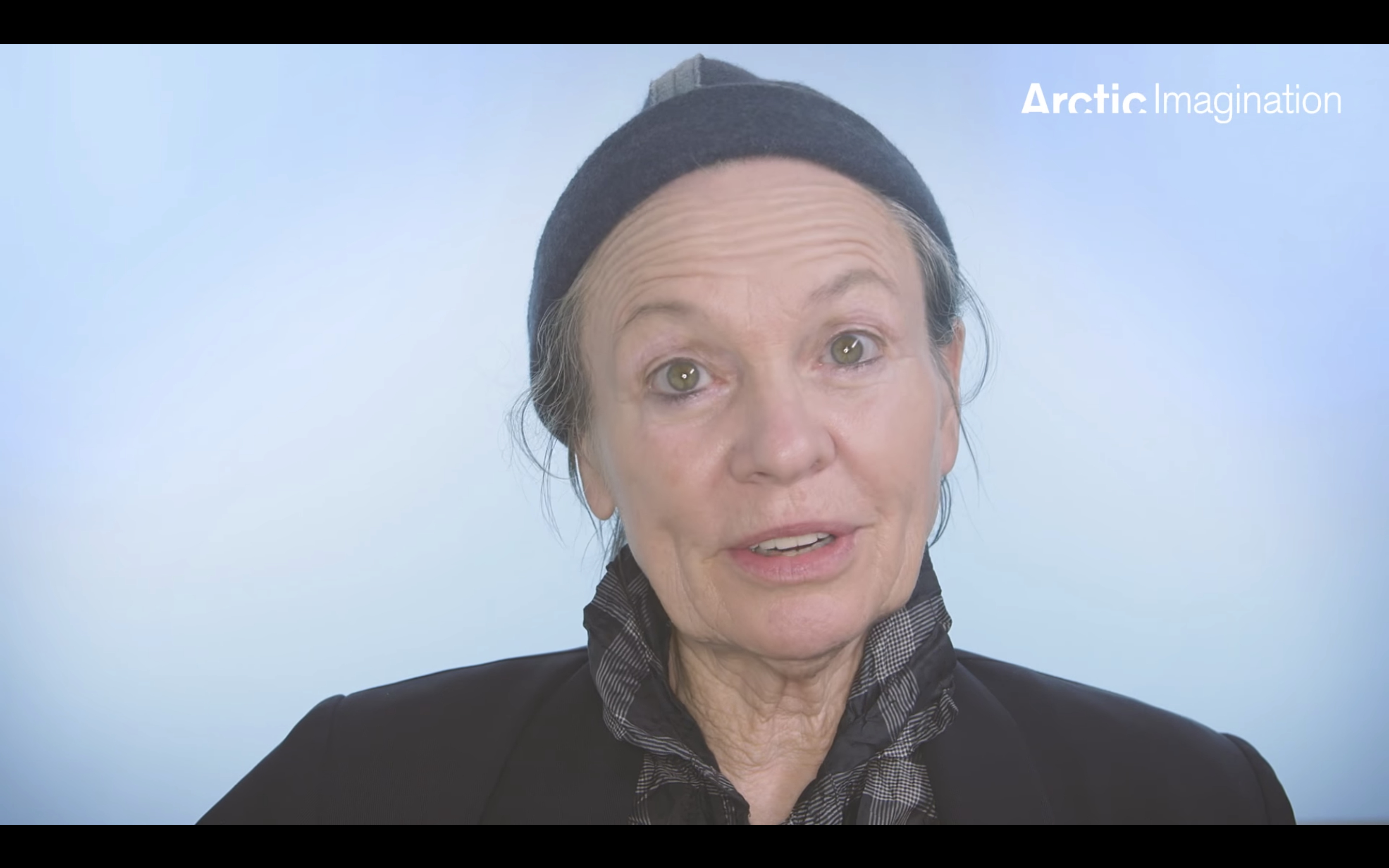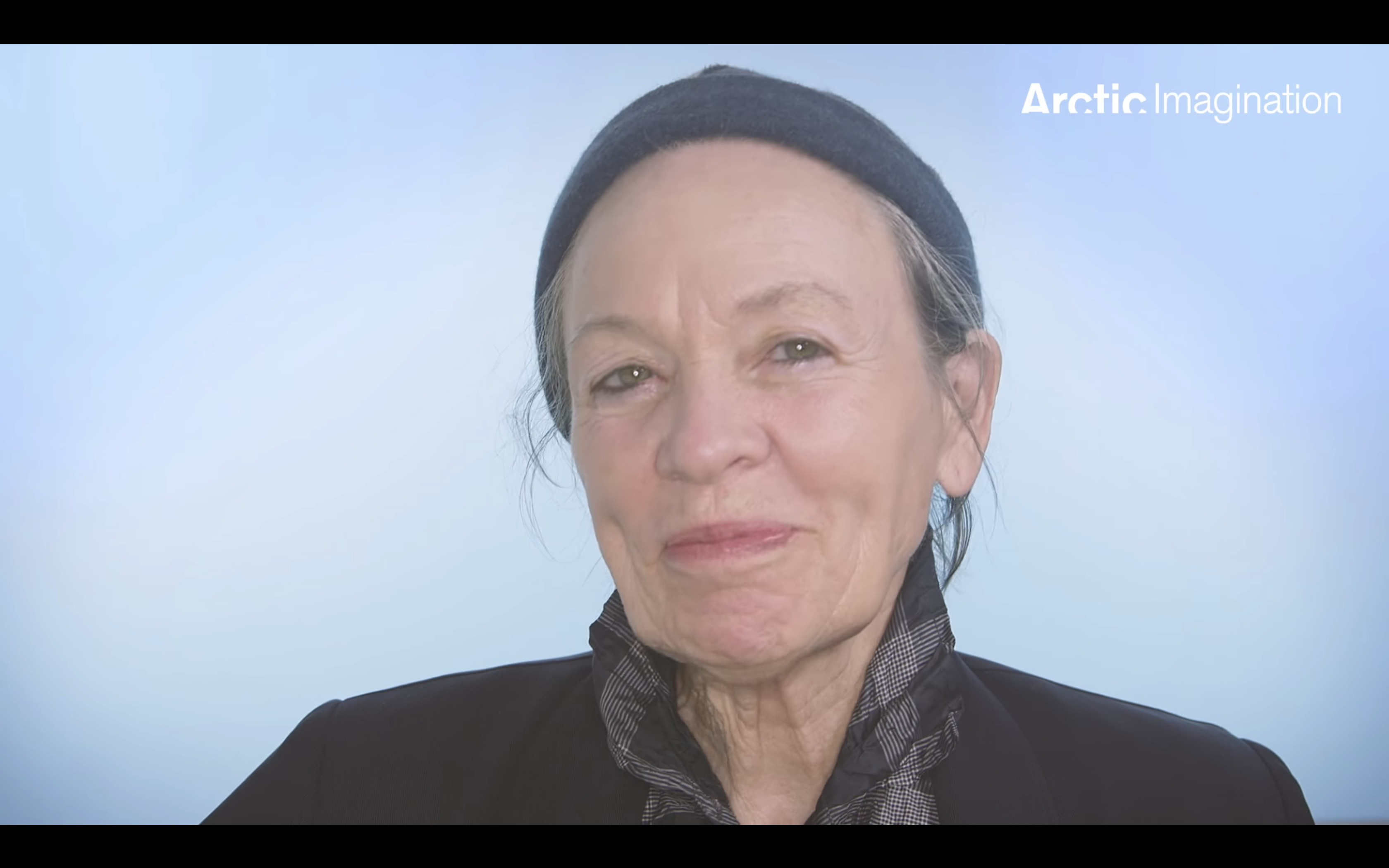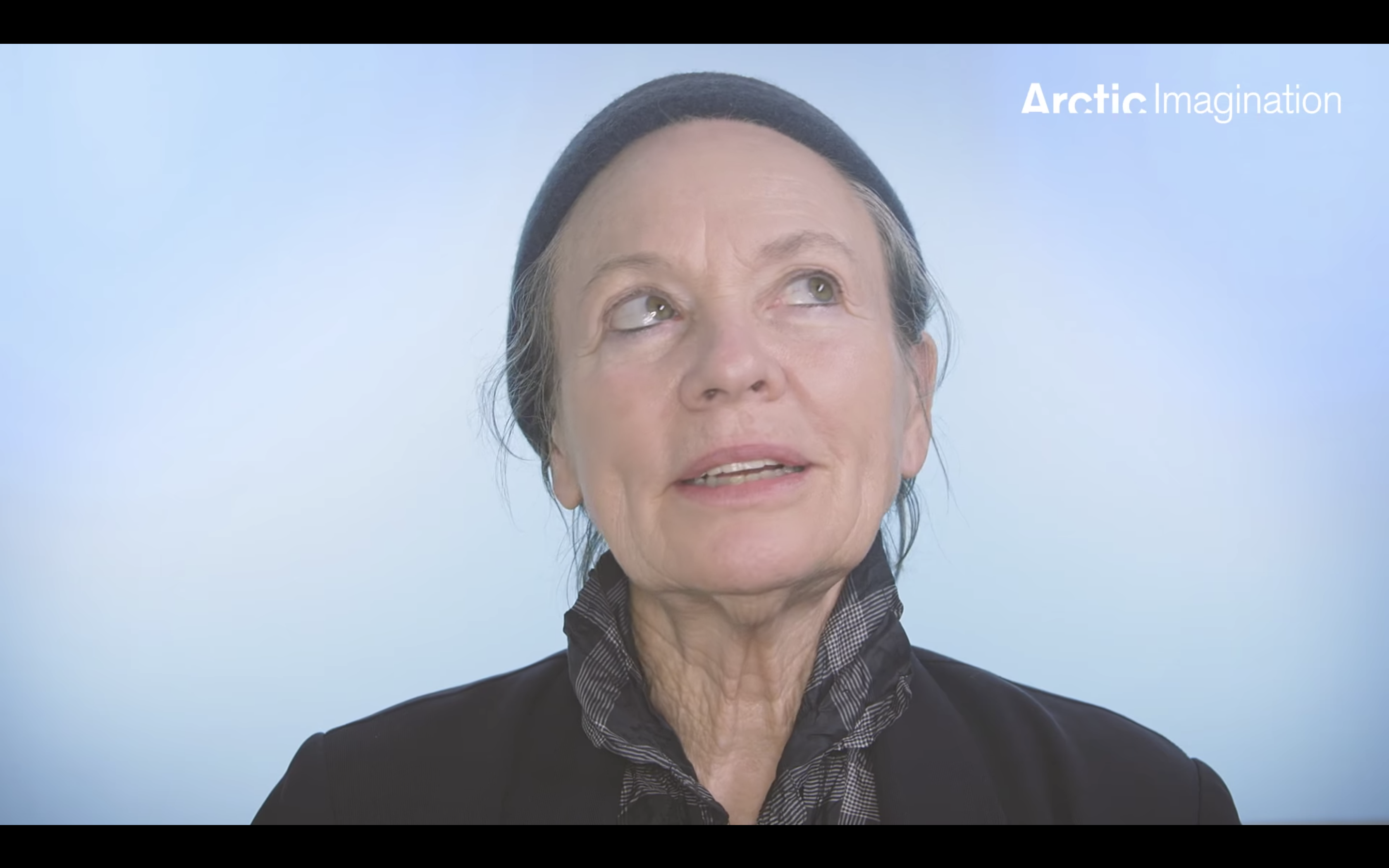different ways to describe the ends of things
notes on Laurie Anderson
Share:

ID: A video still of artist Laurie Anderson, cropped against a light blue-and-white background. Anderson, a White woman in her early 70s, is wearing a dark-blue skull cap that holds back her wispy gray-and-brown hair. She looks directly into the camera, her lips slightly pursed—the beginnings of a smile, or perhaps the end of a sentence. In the top-right corner is a logo for Arctic Imagination, a global collaborative effort centered upon an “artistic take” on the climate crisis. At the bottom of the image is an AI-generated caption line that reads “imagine different ways to describe the ends of things.”
Anderson’s video contribution to the Arctic Imagination project tonally blends a deep and exuberant presence with a meandering and cutting prescience, a palette that is characteristic of all the work made throughout her prolific, inventive, influential, and ongoing career—one that already spans six decades. Throughout the video, Anderson remarks on the current and future states of the climate crisis in response to the prompt “How do you see the future of the Arctic?” She does so, in part, through a discussion of stories and how/why we tell them, focusing not upon climate data, mitigation strategies, or technological solutions but instead upon how we feel and understand that information, upon the knowability of endings. She suggests that, for a culture of good endings or goodish endings, the story of extinction is something that is too traumatic for us to understand. She wonders for us, with us, and in the presence of us. If she is a person whose work is about telling stories to the future, and nobody is there, whom is she talking to? Why is she talking? Anderson forgoes a direct answer to this question and instead shares a story about a story (a familiar motif for fans of her work). She describes a re-evaluation of the character of Moses, within the story of Exodus, wherein Moses is reframed as the reluctant and self-critical leader of what seems to be a futile journey through the desert, with no promise of success. With no ending in sight or in mind, they went anyway. The willingness to do so is clearly something in which Anderson delights.
Anderson has explored rifts, glitches, and slippages as subject matter and as methodology throughout much of her practice, exchanging audiences’ anxious desires for resolution with the warm relief of a pause. A temporary postponement of the extracting and insatiable future. For myself and so many others, Anderson’s work provides an understated and graceful respite from a brutal world of adjacencies. These pauses provoke questions that are needed, though not often comforting. To what degree is our presence required for an ending to be understood as “good?” Are we capable of understanding how our present begets a future that does not feature us? Are we able to imagine something altogether different?

ID: Three stills from Laurie Anderson’s film Heart of a Dog (2015). These images depict a city’s waterfront skyline in three stages of blurring and obfuscation. All three are set against a textured gold-leaf background. In the first image, details of the water and buildings are somewhat discernible. In the second and third images, the footage becomes increasingly foggy and illegible, and the textured gold leaf becomes more defined. Captions spread across the three stills and read, “To live in the gap between the moment that is expiring and the one that is arising, luminous and empty.”
In International Art English, or artspeak, the use of liminal or liminality has been deployed beyond recognition, most often to zhuzh up something that is really just aimless, indeterminate, or willfully inaccessible. An “idk” dressed to the nines. To set aside, however momentarily, a derogatory or dismissive reading of this word choice might enable us instead to consider it as an attempt to operationalize the fantasy of permanence or completeness. To acknowledge that our conception of liminality relies on the idea that it is a state of being in transition between other more recognizable or fixed states—fixed states that we possess a knowledge of.
Anderson’s work, via its convergence of numerous experimental forms, explores political, social, cultural, and spiritual configurations of bodies, borders, language, and notions of futurity. She continually pulls our attention toward the problems of knowledge or the conflict inherent to knowability, what artist William Pope.L refers to as “the fantasy that having is possessing and that possessing is knowing.” Anderson resists this fantasy by using strategies of postponement, humor, error, and an unrelenting and interrogative curiosity.
Heart of a Dog, one of Anderson’s most indelible and affective pieces, articulates the conflation of having, possessing, and knowing by tracing a few of her own experiences with the ends of life—namely of the lives of her friend Gordon Matta-Clark; her husband, musician Lou Reed; her rat terrier/pianist, Lolabelle; and her mother. One of the most poignant moments of the film arrives via Anderson’s reflection upon, and recollection of, the period following the death of Lolabelle. Anderson’s voice drifts over black-and-white footage of a wet and snowy rural road, and a creaking, swaying, leafless winter wood. The caption reads, “and it took me so long to figure it out because death is so often about regrets or guilt …. It’s more about you than [it is about] the person who died. But finally, I saw it … the connection between love and death … and that the purpose of death is the release of love.” This moment recalls an earlier segment of the film in which Anderson explains how Lolabelle was bought from a puppy mill by a couple with a young child. She spent her early life as a witness to the end of their marriage, to their sadness and heartbreak. There, according to Anderson, Lolabelle learned a lesson that Anderson’s meditation teacher had been trying to teach her—that “you should try to learn how to feel sad without being sad.” She pauses before emphasizing the difficulty of differentiating between feeling and being. The film consists of innumerable moments such as these, wherein Anderson brings our attention to the ways in which we know, often exclusively, through possession. In the gaps between, we are left to wonder what this possession continues to foreclose upon. Knowing beyond property, an end to things.

ID: Two video stills from Laurie Anderson’s “Norton Lecture 1: The River.” Both stills feature a grayscale image of Sigmund Freud, the founder of psychoanalysis, against a messy background that resembles a black chalkboard with white, smudged, and illegible handwritten text and drawings. It appears as if there may be water or raindrops on the chalkboard background. The lips of Freud have been animated by Anderson and move in sync with her voice. There are AI–generated caption lines at the bottom of both images. The first reads, “Whose war is this?” The second reads, “What time is it?”
In 2021 Anderson was named Harvard University’s Charles Eliot Norton Professor of Poetry and, over the course of that year, she delivered a series of six Zoom-based lectures-cum-performances titled “Spending the War Without You: Virtual Backgrounds.” All six parts, which have subsequently been made available on YouTube, are densely packed with questions, stories, musings, and meanderings threaded together in typical Anderson fashion. They are an absolute gift and a document of Anderson’s elegant, mischievous, and generous brilliance. Although the nonhuman is regularly featured in much of her work, the Norton lectures are characterized by a deliberate and measured focus upon the ecological. In these talks, the so-called natural is not deployed as something to be measured against, clarified, explained, or managed but, instead, as something that resists and refuses our attempt to possess time, knowing, and existence—an elsewhere beyond the property line.
In “Norton Lecture 1: The River,” the first of the six lectures, Anderson discusses the innumerable ways that water has shaped her creative methodology. She ranges from the regularity of the Hudson River, which her longtime studio overlooks, to a subconscious obsession with—and inclusion of—oceanic plane crashes and shipwrecks in her work, to the influence of her friend and collaborator Brian Eno’s use of the fade-out, which recalls the continuous flow of a river, the suggestion of an eternal music that continues after you leave and “just keeps going on … and on … and on … and on … and on ….” The river and its persistent qualities seem to provide Anderson with some relief, and they pique her creative interest. She has jokingly remarked numerous times about her frustration with the convention of marking something’s beginning and ending: “This is why I never have intermissions in my performances. Then you have to have two beginnings and two endings.”
In the essay “Waters Everywhere,” Anuradha Mathur and Dilip da Cunha write about the relationship between the river and the line. They trace this relationship through the history of mapping practice, noting that the line was used for its geometric form and scalability in service of separation, calibration, and containment. The line creates the implication that there is a clear demarcation between land and river: a falsehood. It is a fantasy that water occupies “clear and distinct space” that self-regulates or self-stabilizes. We cling to the “rationality” that the line provides, even when floodwaters and heavy rainfall indicate otherwise. Mather and da Cunha argue that “the lines of rivers are … products of a particular literacy through which water is read, written, and drawn on the earth’s surface, on paper, and in the imagination.” In consideration of the increasingly deleterious consequences of this containment fantasy, they suggest that perhaps this type of literacy has run its course.
After Hurricane Sandy made landfall in New Jersey in October 2012, storm surge waters flooded Anderson’s Manhattan basement studio storage. Electronic equipment, archives, paintings, books, papers, and props were pulverized by the saltwater of the Hudson River, transforming the basement contents into a “grey amorphous oatmeal pulp.” She was devastated but soon realized that, for her, reading the inventory list of all the things that were in the basement was actually better than having a basement full of things. In reflection, Anderson remarked, “After the storm I went down to the basement and everything was floating. Lots of old analogue keyboards, projectors, props from old shows, a big fiberglass plane, a crutch, a Christmas tree stand, countless papers, photographs of our dog. And I looked at them floating there, all the things I had carefully saved all my life and I thought … how beautiful, how magic, and how catastrophic.”

ID: A series of three sequential video stills from Laurie Anderson’s “Norton Lecture 4: The Road.” The stills feature a computer–generated bust of Anderson—with short gray–and–brown–peppered hair and a white, collared shirt—set against a black chalkboard background with the smudged gray streaks of half–erased text and drawings. Anderson’s digital lips move in glitchy time with her synthesized voice. The AI–generated caption lines read, “and I have no idea which real world I live in, which is known to me, no no no no known. So really, what is really happening when I remind yourself, oneself, help breaking, breaking, into bits, help broken.”
Laurie Anderson – “ Laurie Anderson: We have to Imagine Different ways to Describe the Ends of Things” (screenshot) [courtesy of Youtube]
Laurie Anderson – “ Laurie Anderson: We have to Imagine Different ways to Describe the Ends of Things” (screenshot) [courtesy of Youtube]
Laurie Anderson – “ Laurie Anderson: We have to Imagine Different ways to Describe the Ends of Things” (screenshot) [courtesy of Youtube]
Christopher Robert Jones is an artist and writer based in Illinois. They are a Research Assistant Professor in the College of Fine and Applied Arts at the University of Illinois Urbana-Champaign and the co-founder of Crip*—Cripistemology and the Arts, a creative research project centered around cripistemological approaches to creative production, pedagogy, and applied research.


